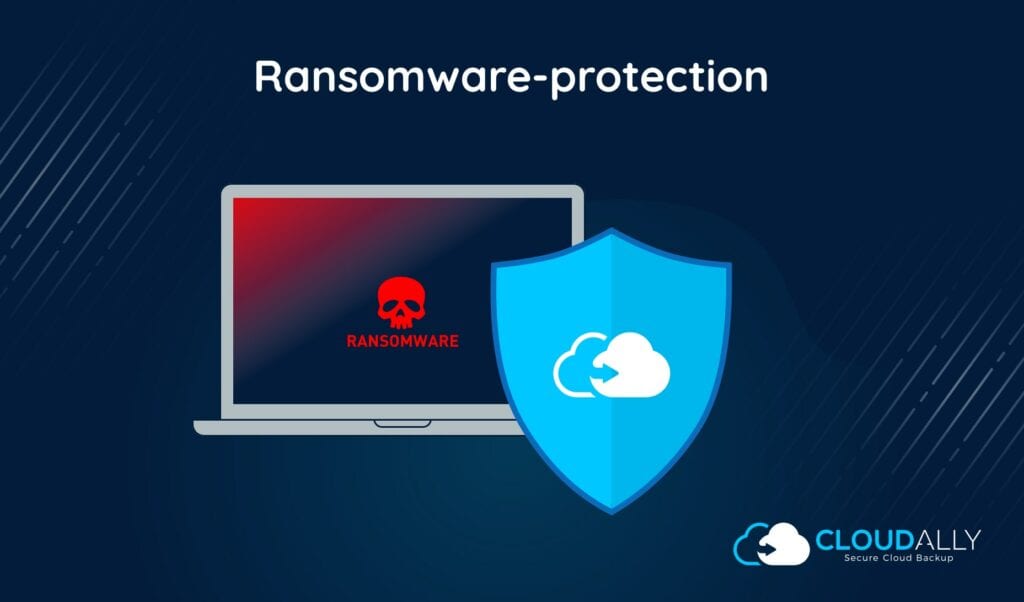What is Ransomware?
Ransomware is a category of malicious software (malware) designed to encrypt files and lock users out of their systems until a ransom is paid. This form of cyber extortion has evolved significantly, leveraging advanced encryption techniques to hold personal, corporate, and even governmental data hostage.
According to Wikipedia, ransomware can range from simple screen-locking malware to sophisticated strains that use cryptographic viral extortion, making decryption virtually impossible without the attacker’s private key.
While many ransomware attacks rely on phishing emails or deceptive downloads, others—such as the WannaCry worm—spread autonomously, infecting systems without user interaction. These widespread infections underscore the urgency of proactive cybersecurity and data resilience measures.
To learn more about the most common attack vectors, read this CloudAlly blog post.
A Growing Threat: The Evolution of Ransomware Attacks
Ransomware has been a persistent cyber threat since at least the early 2010s, with attacks escalating both in frequency and sophistication. The financial impact of ransomware on businesses is staggering:
- 2018: Over 181.5 million ransomware attacks were reported in just the first six months, representing a 229% increase from 2017.
- 2014: Cybersecurity firms like Norton and McAfee had already flagged a dramatic rise in ransomware cases, citing a doubling in attack samples within a single quarter.
- CryptoLocker & CryptoWall: One of the first large-scale ransomware campaigns, CryptoLocker, netted an estimated $3 million in ransom payments before being dismantled. CryptoWall followed suit, inflicting substantial damage before an FBI-led operation neutralized it.
As ransomware tactics evolve, attackers are shifting towards double extortion—not only encrypting data but also threatening to leak sensitive information unless a ransom is paid. This trend underscores the necessity of multi-layered cybersecurity strategies that combine threat detection, incident response, and secure backup solutions.
For a deeper dive into ransomware trends, see CloudAlly’s article on the rise of ransomware.
How Do Ransomware Attacks Infiltrate Systems?
Ransomware typically enters a system through phishing emails, malicious attachments, compromised websites, or infected software downloads. However, attackers have also been known to exploit vulnerabilities in Remote Desktop Protocol (RDP), cloud services, and even backup solutions.
Some key attack vectors include:
- Phishing emails: Cybercriminals craft convincing emails that prompt users to download malicious attachments or click on fraudulent links.
- Software vulnerabilities: Exploiting weaknesses in outdated operating systems and applications allows malware to bypass security defenses.
- Malicious advertising (malvertising): Attackers use online advertisements to inject malware into legitimate websites, infecting users unknowingly.
- Compromised cloud services: Unauthorized access to SaaS applications like Microsoft 365 or Google Workspace can lead to widespread data encryption if proper security measures are not in place.
For a comprehensive guide on securing your SaaS data, visit CloudAlly’s blog on cloud security best practices.
The Role of Backup in Ransomware Defense
While antivirus software, endpoint detection, and firewalls provide essential security layers, they cannot guarantee 100% ransomware prevention. Even with the best security measures in place, ransomware can still bypass defenses through zero-day exploits or human error.
This is where a secure, independent backup solution plays a critical role. By maintaining an immutable, point-in-time backup, organizations can restore their data to a clean version before an attack—eliminating the need to pay ransom demands.
Key Features of an Effective Backup Strategy:
- Automated, regular backups: Ensures data is continuously protected without manual intervention.
- Immutable, point-in-time recovery: Allows restoration of clean data from before the infection occurred.
- Offsite and third-party storage: Protects against malware that attempts to encrypt or delete backups.
- Granular recovery options: Enables restoration of individual files, emails, or entire systems.
- Long-term retention policies: Provides historical data recovery for compliance and auditing purposes.
CloudAlly’s automated cloud backup solutions offer these features and more, ensuring that businesses can recover from any cyberattack swiftly and securely. See how SaaS backup can help with seamless ransomware recovery
Case Study: The Consequences of Not Having a Backup
Numerous real-world incidents illustrate the devastating consequences of failing to implement a secure backup strategy.
One notable example is the attack on the UK’s National Health Service (NHS) by the WannaCry ransomware. The attack crippled hospital systems, forcing medical staff to revert to pen-and-paper operations, delaying treatments, and endangering patient care. Had NHS systems maintained a robust cloud backup solution, critical data could have been restored without significant downtime.
To explore more real-world ransomware incidents, check out CloudAlly’s case study on ransomware in healthcare.
Final Thoughts: No Ransom Needed—Just a Reliable Backup
The best defense against ransomware is a proactive approach—combining cyber hygiene, strong authentication, endpoint protection, and an independent backup solution.
With CloudAlly’s automated daily backups for Microsoft 365, Google Workspace, and other SaaS applications, organizations can:
✔ Recover lost data from any point in time—without paying a ransom.
✔ Ensure business continuity, even in the face of cyber threats.
✔ Meet compliance requirements with long-term data retention.
By implementing a resilient backup strategy, businesses can safeguard their most valuable digital assets against ransomware, system failures, and human error.



